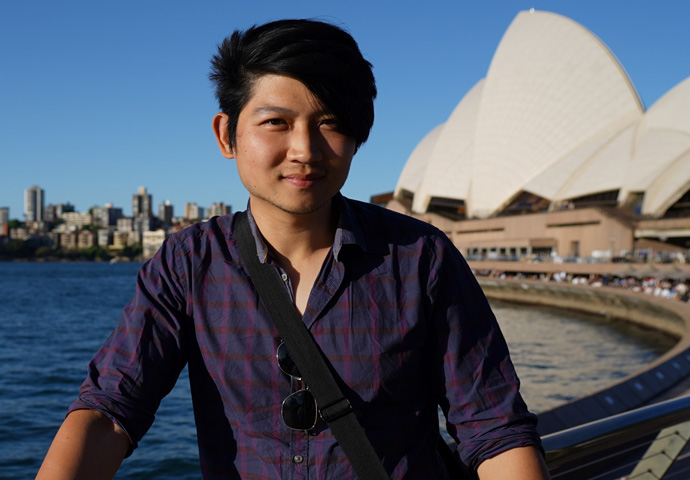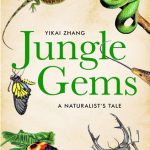One man’s beetlemania
Insect hunter Yikai Zhang’s bizarre adventures in search of bugs
Thursday, 10th July — By Dan Carrier

An illustration from Jungle Gems by Yikai Zhang
A FLASH and sheen of emerald green, the iridescent Carabus beetle’s beautiful appearance hides a less attractive trait. It squirts a toxic acid when attacked, and apparently has the ability to aim specifically for the eyes.
For Yikai Zhang, it was a painful encounter. At the top of a mountain on a small Pacific island, having trekked through forest and scrambled up hills, he thought he might have scooped the prize he had travelled around the world to find.
But the beetle had other plans – and after shooting its toxin, forcing Yikai to drop the creature, it escaped, not to be seen again.
Yikai tells this story of his search for the beetle on Hainan Island in his delightful book, Jungle Gems.
“When I received a box of specimens from Hakamoto, an insect dealer from Japan with whom I had professional dealings, I noticed a specimen from the island of Hainan, where it had never been known to exist,” he explains.
Carabus is a name that covers more than 1,000 different species of ground beetles and is an enigmatic group, as Yikai calls them. The Hainan Carabus was likely not to have been noted before – so he set off, armed with insect traps and other equipment, for the Pacific island.

Yikai Zhang: ‘Nature has taught me patience, focus and tenacity’
His book reveals what happens to an insect hunter – but is also about a person’s obsession with insects, and an insight into a strange industry that draws in naturalists. It is a world that is not always what it seems.
Yikai was born in the southern Chinese city of Hang Zhou. “My fascination with insects started when I was about four,” he recalls.
“My grandfather enjoyed fishing and would take me with him.
“I wasn’t interested in the fishing – but there were plenty of trees and bushes that were just full of bugs. My grandfather showed me some fascinating insects, like big cicadas – I wondered how they could be so loud. They were well camouflaged, but my grandfather could pluck them down from the trees. It was quite magical.”
Yikai moved to London aged seven and went to school in Camden Town.
“When I was 13, I decided I would do something with my interest in insects, something that went beyond just catching them, looking at them and then letting them go. I started collecting beetles.”
He began rearing his own specimens and aged 16, while on a collecting trip to Richmond Park he found a larvae of a beetle that had been attacked by a parasite, so he took it to the Natural History Museum. It was possibly the third time it had been seen in the UK – and Yikai was introduced to the museum’s beetle expert, Max Barclay. He would go on to volunteer at the museum while studying at Westminster School, and Max would encourage him to become a collector.
“I decided I wanted to become an entomologist,” he recalls. “Beetles can be used as a tool to get people interested in the natural world around them.”
In the book, Yikai tells a saga of a solo collecting trip. He has blended a number of experiences together to create an adventure story that feels similar to John Steinbeck’s Log From The Sea of Cortez, or Gerald Durrell’s adventures.
The tale begins when Yikai is employed by the mysterious insect dealer Hakamoto to draw a box of specimens. He is allowed to keep the collection in lieu of pay – and he doesn’t recognise one of the bugs, so shows it to his mentor, Max.
Where was it found? What is its genus? Could it be a whole new type of beetle? He packed his collecting gear and set out to find out.
“The book is a conglomeration of my experiences on trips, and dealing with entomologists,” he adds. “They are all fairly unusual – and some are more unusual than others. Hakamoto is a composite of a number of beetle dealers.”
Yikai reveals how some unscrupulous people in the trade lie about where they have found specimens. It’s a long-standing issue, he explains.
“In Victorian times, people would go to France and bring back moth and butterfly pupae. They’d tie them to a tree and then on a warm day, say to their collecting friends, ‘let’s take our nets and go somewhere I know.’ They’d walk along and lo-and-behold, there would be this rare butterfly and the person who caught it would become a living legend. People do this.
“I have seen people sell specimens that are clearly captive bred, but they make up fake data labels. They catch an insect in one place and then take it somewhere else.”
This fascination with collecting and collating has helped with giant moments in our understanding of our natural world.

Illustration from Jungle Gems
As Jungle Gems points out, when the Endeavour sailed around the world with Captain Cook at its helm 250 years ago, naturalist Joseph Banks went with him and brought back hundreds of zoological and botanical specimens for further study. This trend continued through the Victorian period.
And as Max Barclay says in the foreword: “As Yikai’s highly entertaining, thought-provoking and beautifully illustrated book shows, it is far from over today.”
Time is of the essence: “With the destruction humans have wrought on the natural environment, discovery and documentation of nature have acquired a new urgency, and the great museums that collate and distil the fruits of these voyages are becoming ever more important as archives of the world’s biodiversity.”
Beetles are arguably the most diverse group of organisms on the planet with more than 400,000 species so far named by science – and as the book points out, Darwin was a beetle collector, as was Alfred Russel Wallace, both key pioneers of evolutionary thought. These supposedly little creatures has had a colossal impact on human thought.
As Yikai says of his field: “The simple answer is that they’re incredibly diverse and colourful and I find them fascinating, but you’ll get that answer from anyone who claims to be interested in insects.
“I believe thinking about the lives of insects (and indeed nature in general) encourages us to be more introspective about our own.
“One can’t help but begin to ponder life’s great mysteries when we watch generations of these tiny insects rise and fall before us like the evening tide. Insects are the details for the wonderful world we live in.
“Nature has taught me patience, focus and tenacity, to be grateful for the life I have been given and to explore the enormous potential that lies within everyone of us.”
And he states the book could use anything in the natural world to illustrate his point: “The crustacean community in a rock pool, the seeds of the deciduous trees in a hedgerow or the minerals in a drop of pond water,” he says.
“There is often more to these ‘trifles’ than meets the eye, and that they contain enough wonder and complexity for a whole lifetime of study.”

• Jungle Gems: A Naturalist’s Tale. By Yikai Zhang, Unbound, £20